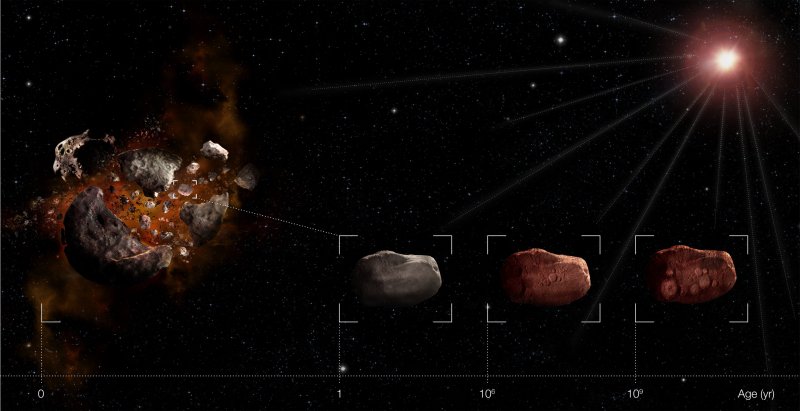It has long been known that asteroid surfaces alter in appearance with time. Observed asteroids are much redder than the interior of meteorites found on Earth; a meteorite that enters the Earth's atmosphere will be partially charred by the intense heat but the meteorite interior remains unaffected and can be studied in a laboratory, providing a wealth of information on the nature and composition of asteroids — but the actual processes of this observed “space weathering” in asteroids and the timescales involved were controversial.
Using observations of different families of asteroids with ESO’s New Technology Telescope at La Silla and the Very Large Telescope at Paranal, as well as telescopes in Spain and Hawaii, Vernazza’s team say they have now solved the puzzle.
The surface of an asteroid is affected by the highly energetic particles forming the solar wind. These particles partially destroy the molecules and crystals on the surface, rearranging them in other combinations. Over time, these changes give formation of a thin crust or irradiated material with distinct colors and properties.

Artist’s impression of how the solar wind makes young asteroids look old. After undergoing a catastrophic collision, the color of an asteroid gets modified rapidly by the solar wind so that it resembles the mean colour of extremely old asteroids. After the first million years, the surface “tans” much more slowly. At that stage, the colour depends more on composition than on age. Credit: ESO/M. Martins
“The charged, fast moving particles in the solar wind damage the asteroid’s surface at an amazing rate,” says lead author Pierre Vernazza. Unlike human skin, which is damaged and aged by repeated overexposure to sunlight, it is, perhaps rather surprisingly, the first moments of exposure (on the timescale considered) — the first million years — that causes most of the aging in asteroids.
By studying different families of asteroids, the team has also shown that an asteroid’s surface composition is an important factor in how red its surface can become. After the first million years, the surface “tans” much more slowly. At that stage, the colour depends more on composition than on age. Moreover, the observations reveal that collisions cannot be the main mechanism behind the high proportion of “fresh” surfaces seen among near-Earth asteroids. Instead, these “fresh-looking” surfaces may be the results of planetary encounters, where the tug of a planet has “shaken” the asteroid, exposing unaltered material.
Thanks to these results, astronomers will now be able to understand better how the surface of an asteroid — which often is the only thing we can observe — reflects its history.
Article: “Solar wind as the origin of rapid reddening of asteroid surfaces”, by P. Vernazza et al. The team is composed of Pierre Vernazza (ESA), Richard Binzel (MIT, Cambridge, USA), Alessandro Rossi (ISTI-CNR, Pisa, Italy), Marcello Fulchignoni (Paris Observatory, France), and Mirel Birlan (IMCCE, CNRS-8028, Paris Observatory, France). Nature, doi:10.1038/nature07956





Comments